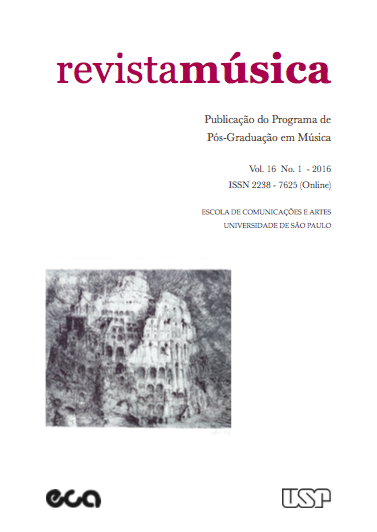Mensural Elaboration and Motivicity in the Agnus Dei from Missa L’hommeArmé Super Voces Musicales by Josquin Desprez
DOI:
https://doi.org/10.11606/rm.v16i1.125011Keywords:
mensural elaboration, motivicity, canon, Josquin Desprez, Missa L’homme armé.Abstract
This work consists in analysis of the mensural elaborations and aspects of motivic periodicity present in the Agnus Dei from the Missa L’homme Armé Super Voces Musicales by Josquin Desprez. The analysis is based from the appointments on mensuration-canons made by Glareanus (Dodechocordon, 1547), Bellermann (Mensuralnoten Taktzeichen und des XV. Und XVI. Jahrhunderts, 1906), Apel (The Notation of Polyphonic Music 900-1600, 1949) through of concepts of ‘Motivicity’ by Joshua Rifkin and ‘Agrupamentos Sonoros Plenos’ by Marcos Pupo Nogueira, elucidating characteristics of compositional strategies used by the composer.Downloads
References
APEL, Willi. The Notation of Polyphonic Music 900-1600. Cambridge: The Mediaeval Academy of America, 1949.
BELLERMANN, Heinrich. Mensuralnoten und Taktzeichen des XV. und XVI. Jahrhunderts. Berlim: Georg Reimer Verlag, 1906.
BROWN, Howard Mayer. Music in the French Secular Theater. Boston: Harvard University Press, 1963.
CERONE, Pietro. El melopeo y maestro. Napoli: Ivan B. Gargano & Lucrecio Nucci, 1613.
CEULEMANS, Anne-Emmanuelle. Les messes L’Homme armé de Josquin des Prez. Musurgia. Paris, v. 7, n. 1, p.29-43, 2000.
DEFORD, Ruth I. De. Tactus, Mensuration and Rhythm in Rennaissance Music. Cambridge: Cambridge University Press, 2015.
__________. Sebald Heyden (1499-1561): The first historical musicologist?. In: BLAŽEKOVIĆ, Zdravko e Barbara Dobbs Mackenzie (eds.). Music’s Intellectual History. New York: Répertoire International de la Littérature Musicale, 2009, p.3-15.
DISNEY, Kenneth Dale Lee. The Missa L’homme arme of Johannes Regis and Franco-Flemish Perceptions of St. Michael the Archangel. 125 p. Dissertação (Mestrado em Música), University of Tennessee, Knoxville, 2008.
EGGEBRECHT, Hans Heinrich. Terminologie der musikalischen Komposition. Berlin: Fraz Steiner Verlag, 1996.
FALLOWS, David. L’homme armé. In: SADIE, Stanley e John Tyrell (eds.). The New Grove Dictionary of Music and Musicians. London: Oxford University Press, 2001.
GLAREANUS, Henricus. Dodecachordon. Basel: Heinrich Petri, 1547.
HAMM, Charles e Herbert Kellman (eds.). Census-Catalogue of Manuscript Sources of Polyphonic Music 1400-1550. University of Illinois: Musicological Archives for Renaissance Manuscript Studies, American Institute of Musicology, 1979-1988 (5 volumes).
LOCKWOOD, Lewis. ‘L’Homme armé’ Tradition. Proceedings of the Royal Musical Association. Manchester, v. 100, p. 97-122, 1973-1974.
MILSON, John. Crecquillon, Clemens, and four-voice fuga. In: JAS, Eric (ed.). Beyond Contemporary Fame Reassessing the Art of Clemens non Papa and Thomas Crecquillon. Brepols: Epitome Musical, 2006.
__________. Analysing Josquin. In: SHERR, Richard. The Josquin Companion. New York: Oxford University Press, 2000, p. 431-484.
NEWES, Virginia. Mensural Virtusoity in Non-Fugal Canons c. 1350 to 1450. In: SCHILTZ, K. e Bonnie J. Blackburn. Canons and Canonic Techniques, 14th-16th Centuries: Theory, Practice, and Reception History. Leuven: Peeters, 2007, p. 20-46.
NOGUEIRA, Marcos Pupo. Agrupamentos sonoros plenos: uma ferramenta analítica. para o estudo das formas instrumentais da polifonia imitativa do século XVI. In: Anais do XV Congresso da ANPPOM, Vitória, 2015. Disponível em: http://www.anppom.com.br/congressos/index.php/25anppom/Vitoria2015/paper/view/3411/1130. Acesso em 03 mai. 2016.
OWENS, Jesse Ann. Composers at Work: the craft of musical composition, 1450-1600. New York: Oxford University Press, 1997.
RIFKIN, Joshua. Miracles, Motivicity, and Mannerism: Adrian Willaert’s ‘Videns Dominus flentes sorores Lazari’. In: PESCE, Dolores. Hearing the Motet. New York: Oxford University Press, 1997, p 243-299.
RODIN, Jesse. Josquin and the Polyphonic Mass in the Sistine Chapel. Harvard University. 434f. Tese de Doutorado em Música. Instituto de Artes e Ciências, Harvard University, Cambridge, 2007.
__________. “When in Rome...”: What Josquin Learned in the Sistine Chapel. Journal of the American Musicological Society. California, v. 61, n. 2, p. 307-372.
SCHILTZ, Katelijine. Music and Riddle Culture in the Renaissance. Cambridge: Cambridge University Press, 2015.
SCHUBERT, Peter. Hidden Forms in Palestrina’s First Book of Four-Voice Motets: In Journal of the American Musicological Society. California, v. 60, n. 3, p. 483-556. 2007.
SMIJERS A. Missa L’Homme Armé. Amsterdam: Prostat Apud G. Alsbach & Co., 1957.
VICENTINO, Nicola. L’antica musica ridotta alla moderna prattica. Roma: Antonio Barre, 1555.
Downloads
Published
Issue
Section
License
Copyright (c) 2016 Carlos C. Iafelice

This work is licensed under a Creative Commons Attribution-NonCommercial-ShareAlike 4.0 International License.
Autores que publicam nesta revista concordam com os seguintes termos:
- Autores mantém os direitos autorais e concedem à revista o direito de primeira publicação, com o trabalho simultaneamente licenciado sob a CC Attribution-NonCommercial-ShareAlike 4.0 que permite o compartilhamento do trabalho com reconhecimento da autoria e publicação inicial nesta revista.
- Autores têm autorização para assumir contratos adicionais separadamente, para distribuição não-exclusiva da versão do trabalho publicada nesta revista (ex.: publicar em repositório institucional ou como capítulo de livro), com reconhecimento de autoria e publicação inicial nesta revista.
- Autores têm permissão e são estimulados a publicar e distribuir seu trabalho online (ex.: em repositórios institucionais ou na sua página pessoal) a qualquer ponto antes ou durante o processo editorial, já que isso pode gerar alterações produtivas, bem como aumentar o impacto e a citação do trabalho publicado (Veja O Efeito do Acesso Livre).


